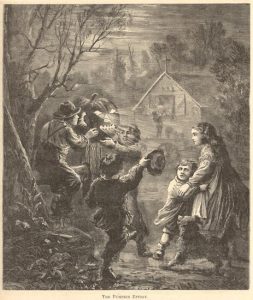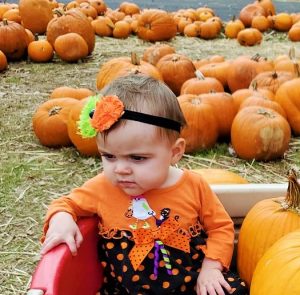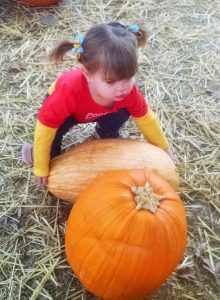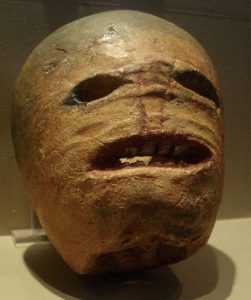Having consumed all the pawpaws, I’ve turned to pumpkins. Pumpkins, too, are a native fruit. (Yes, botanically, pumpkins are fruits, a type of berry known as a pepo, to be precise. But cooks and diners commonly class pumpkins with vegetables—along with squash, tomatoes, eggplant and other “vegetables” that have their seeds on the inside—allowing pawpaw to be the largest native food that is considered and eaten as fruit.)
Pumpkin History

Pumpkins and winter squash are native to the Americas, from the southwestern part of what is now the United States through much of central and South America. People have cultivated pumpkins at least since 3500 B.C.E. Corn and pumpkins are the oldest known crops in the western hemisphere.
And who hasn’t heard about the Cahokian, Muscogee, and Iroquois “three sisters” system of companion planting: corn, beans, and squash/pumpkins grown together to the benefit of all.
Native peoples baked pumpkins whole in wood ashes, stewed them, and sometimes made a sort of succotash with beans and corn. Pumpkin was a popular ingredient in meat stews. They roasted long strips of pumpkin on an open fire until edible
Roasted seeds were (and are) eaten as a delicacy. In fall, people cut pumpkins into rings and hung up the strips to dry, later to grind the strips into flour to add to bread.
Perhaps more unexpectedly, Native Americans dried strips of pumpkin flesh and wove them into mats. And, they made a fermented drink from pumpkins. (Researchers have recently found that fermenting pumpkin reduces insulin-dependent sugars, making it a particularly suitable beverage for diabetics.)
Native Americans introduced colonists to pumpkins and they, too, relied heavily on pumpkin for food as evidenced by this poem (circa 1630):
For pottage and puddings and custard and pies,
Anonymous Plymouth Plantation colonist
Our pumpkins and parsnips are common supplies:
We have pumpkins at morning and pumpkins at noon,
If it were not for pumpkins, we should be undoon.
Early colonists used pumpkins as the Native Americans taught them, also making pumpkin butter (similar to apple butter) and pumpkin syrup (as a substitute for molasses).
During the Revolutionary War, they made pumpkin sugar! (Pumpkin, Pumpkin, Anne Copeland) FYI: at one time, the Port of Boston was called Pumpkinshire.
Now, eating pumpkin is more seasonal. Come October, one can easily find pumpkin muffins, bread, meatloaf, soup, ice cream, and drinks. Thoughts of pumpkin pie stir. (FYI, the canned product sold for making pumpkin pies actually is Cucurbita moschata, a species of winter squash. The FDA does not distinguish among varieties of squash when labeling canned foods.)
Pumpkin Folklore

Although once an important food source, pumpkins are now more prominent in Halloween and Thanksgiving decorations.
Jack-o-lanterns originated in Ireland. According to legend, Stingy Jack fooled the devil so many times that when Jack arrived at the gates of hell, the devil wouldn’t let him in. Instead he sent him off into the night with a burning lump of coal, which Jack put into a hollowed out turnip and has been roaming the Earth ever since.
“If you knew the sufferings of that forsaken craythur, since the time the poor sowl was doomed to wandher, with a lanthern in his hand, on this cowld earth, without rest for his foot, or shelter for his head, until the day of judgment… oh, it ‘ud soften the heart of stone to see him as I once did, the poor old dunawn, his feet blistered and bleeding, his poneens (rags) all flying about him, and the rains of heaven beating on his ould white head.”
Dublin Penny Journal 1836
Immigrants to America continued the tradition of making jack-o-lanterns but switched to easier to carve pumpkins. The influx of Irish immigrants in the 18th and 19th centuries greatly increased the popularity of Halloween celebrations. They adapted the customs and traditions of Samhain to their new homes in North America, including dressing in costumes, trick-or-treating, pranking houses, and carving jack-o-lanterns.
Pumpkin Varieties
Imagine a pumpkin. Chances are, what came to mind first was a “typical” pumpkin, 12-18 pounds, oblong and orange, as commonly seen around and about in October, suitable for painting and carving. But consider the variety!
One of the most popular miniature pumpkin varieties is Jack Be Little, orange, about 3” in diameter and 2” high. Typically used for fall decorations, they’re also edible and grow well on trellises, making them ideal for small growing spaces.
Baby Boo are small white pumpkins, also suitable for decorating and eating. Each plant produces about 10 pumpkins. Extreme sun and frost don’t affect growth adversely.
At the other end of the continuum, you’ll find giant pumpkins: in 2022, a pumpkin set a new North American record, weighing 2,560 pounds. This was at the 49th Safeway World Championship Pumpkin Weigh-Off in Half Moon Bay, California, though Travis Gienger grew the pumpkin in Minnesota.
Half Moon Bay considers itself the pumpkin capital of the world because local growers produce more than 3,000 tons of pumpkins each year. But in 2021, Stefano Crutupi, an Italian grower, set the world record for giant pumpkins with a 2,703 pound pumpkin.
Pumpkin Celebrations

To truly appreciate pumpkins, go to a pumpkin festival. My home state of Ohio hosts the Circleville Pumpkin Show—“The Greatest Pumpkin Show on Earth”—always held the 3rd Wednesday through Saturday in October. There is, of course, every pumpkin food and beverage you might want available for purchase. Plus you can enjoy a giant pumpkin weigh-in, pumpkin carving demonstrations, and the crowning of Little Miss Pumpkin Show. And concerts for music lovers (this year featuring DJ Tune Stoned and The Poverty String Band).
The New Hampshire Pumpkin Festival boasts the largest display of lit jack-o-lanterns every year. At the Great Pumpkin Farm in Clarence, NY, visitors can “hunt zombies” in paintball tournaments. Stone Mountain, GA has an annual Play By Day / Glow By Night Pumpkin Festival at the end of October. Milton, WV hosts an annual Pumpkin Park at the beginning of October.
Truth be told, once upon a time, I used canned pumpkin for cooking and fresh pumpkins only for jack-o-lanterns . But when I had three daughters, and thus three pumpkins, I couldn’t bear the waste, and started collecting pumpkin recipes. I once thought of writing The Great Pumpkin Cookbook, but never got beyond a notebook full of clippings. I lost momentum when I found the following:



But I will share one pumpkin soup recipe, I made up based on a side dish my son-in-law made.
Savory Pumpkin Soup
1-2 cloves chopped garlic
Chopped onion
Vegetable or olive oil to sauté
Equal amounts of pumpkin puree and diced canned tomatoes
Vegetable or chicken broth
Optional: your favorite herb or spice, such as basil, curry, etc.
Blue cheese or feta cheese
Gauge the garlic and onion on the basis of your taste and the amount of soup you are making. (For 15 oz. cans of tomatoes and puree, I use 1 clove of garlic and half a medium onion.) Sauté garlic and onion till soft. Add the pumpkin and tomatoes, and enough broth to make a soup of the consistency you like. If using additional seasonings, add now. Simmer to blend. When hot, add cheese to taste and stir to melt.
BOTTOM LINE: there’s a lot more to pumpkins than decorations and pie!
























